X420
SL Pendeltåg (in Swedish) Home På svenska Auf Deutsch
X420 060 + 044 arrives at Barkarby on 11 May 2004.
An odd train in the Stockholm
commuter train (pendeltåg) services
In the beginning of year
2001, the Stockholm PTA SL had found
a foreign train, which could be suitable for the Stockholm commuter trains
services, without too much work, before the new EMUs X60 were delivered. It
was the German commuter train EMU ET 420, which was put in service in the 1970’s on the
commuter train networks in Munich, Rhein-Main (with Frankfurt as central
place), Stuttgart, and partly also Rhein-Ruhr (with before Dusseldorf, now Essen
as central place). The project was more complicated than one first expected,
partly due to the negotiations with the German railways Deutsche Bahn (DB) and the demands
on adjustments on the work environment conditions from the Swedish train driver
unions Seko and ST Spårtrafik at the
TOC Citypendeln, as well as from the Swedish Work Environment Authority Arbetsmiljöverket.
The X420 EMUs were delivered
in following order: 060 (Forerunner), 062, 047, 058, 119, 027, 065, 110, 026,
020, 117, 021, 067, 054, 044 and 060 (final status).
The trains belonged to DB Regio Sverige AB (DBS), a
100 % subsidiary to DB Regio AG, which also ran the service on behalf of SL.
DBS used the TOC Citypendeln as a subcontractor for the services. Citypendeln
was manning and maintaining the trains. The contract was due at the end of year
2005. On top of that, Citypendeln used Swedtrac in Hagalund as subcontractor for maintenance on
half of the X420-fleet for about a year.
Citypendeln made a plan for
the successive withdrawal of the EMUs during 2005. The limit was set at 240,000
kilometres, which also meant exam ‘Ö4’, which wasn’t done on the X420 EMUs. The
scrapping started in October 2005 and was completed in February 2006. The train
units were sent away due to performed kilometres and the status on the trains.
On 27 October, the EMUs 047 + 060 + 117 were driven to Nykroppa scrap yard in
western Sweden (Värmland county). The next three units (062 + 062 + 110)
followed on the 4 November, and the three thereafter (026 + 065 + 119) followed
on 25 November. On the 12 December, the EMUs 027 + 067 followed. The final
commercial X420-service with 044 + 058 took place on 14 December 2005. On
16 December 2005, these two units, plus 054, were also driven to Nykroppa
scrap yard. The unit 021 was finally transferred from Motala Works to Nykroppa
on 4 February 2006.

An X420-train passes the level crossing Esplanaden in Sundbyberg on 4 February 2004.
Why the class X 420?
In Sweden,
these trains became the classification X420. It followed the modern practise,
where one added the ‘classic’ (SJ-) class (here X for EMU) to the original
class from the country of origin (in this case: 420). Other examples are the
diesel locomotives T66 (Class 66), TMX, TMY, TMZ (Danish Nohab diesel locos Mx,
My and Mz with EMD engines). The EMU got its number from the A-car, e.g. 027.
One unit contained three cars; A+M+B, where the A- and B-cars were end cars,
and the M-car was in the middle. All three wagons were motorised, but differed
from each other (the end cars had driver’s cabins, the intermediate cars had pantographs,
and different equipment was places over (i.e. underneath!) the whole EMU, hence
different classification for the end cars (420; Driving Motor Second Open,
DMSO), and the intermediate car (421; Pantograph Motor Second Open, PMSO). The
A- and B-cars became different numbers, where the B-car had a number 500 higher
than the A-car.
An example:
X420 027 contained 420 027-5 (A) + 421 027-4 (M) + 420 527-4 (B).
It’s odd,
that you could find four (!) different ways of number marking on the front ends
on the 15 units. The first four delivered units (062, 047, 058 and 119) didn’t
carry any numbers in the front from the beginning. To be able to indentify them
at all, a DB official marked three of them with small numbers on the coupling
cover. 119 wasn’t marked in the front at all. 027 was the first unit with
larger front numbers, though smaller than on the rest of the units (and the
X1/X10 EMUs). Even the 065 had those smaller numbers at first, but they were
changed, before the EMU left the Motala Works. The B-car on the 058 became
finally larger numbers in the summer of 2005.
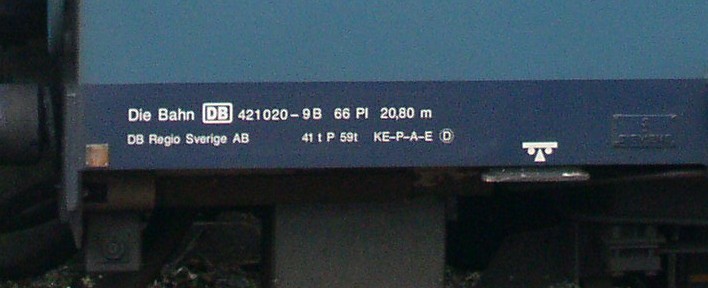
Though the frame marking was the same on all units, and above you
see the one from 421 020-9. The units were registered in Germany, hence
the standard German way of number. The German railways Deutsche Bahn used ‘Die
Bahn’ (The Railway) as market slogan, also used also by the Deutsche Bundesbahn
back in the 1980s! DB Regio Sverige AB was the formal owner of the EMUs. ‘B’
after the number is for 2nd class. 66 seats were available, and the
wagon was 20.8 meters long. The service weight was 41 tonnes and the brake
weight in P-mode was 59 tonnes. KE-P-A-E showed the different functions of the
KE-brake. Finally, ‘D’ shows that it had disc brakes.
More information
I have written two articles
in the Swedish railway magazine Tåg (published by the Swedish Railway Association ‘SJK’)
about the X420 EMUs; Sagan om det
tyska tåget (something like The Fairy Tale about the German train)
in the issue 9/2002 and X420 -
Stockholms nygamla pendeltåg (something like X420 – The New-old
Commuter Train for Stockholm) in the issue 11/2003. For technical data,
please look at the X420-data sheet
from DBS (in Swedish).
Below, I present you the units
in number order. Three years of ‘sharp’ service will be a parenthesis in the
whole Pendeltåg history, but the X420-trains worked hard during this
period, although the wind blew hard against them.
X420 020
X420 020 + 119 are waiting for the permission to leave the station
Nynähamn on the Nynäs branch line on 11 February 2004. It was a test run,
to see if a two-unit train set could fit on the line south of Västerhaninge.
The result was more or less clear before the trip; a two-unit train set was
Rush hour in Skogås on 3 September 2004. X420 520 heads the Västerhaninge to
Kungsängen service. The unit was taken out of service on 4 November 2005, and
was directly sent away to the scrap yard.
X420 021
On the 17 October 2003, the ‘Twenty-one’ arrives in Sundbyberg.
X420 021 in Bålsta on 31 July 2004. During a part of the summer of 2004, the
X420 was diagrammed for a Bålsta to Västerhaninge service on Saturdays.
On 9 September 2004, a train bound for Kungsängen headed by X420 521, passes
the Solvalla trotting course and the level crossing Sulkyvägen. Shortly
after at Duvbo, it will pass the cross-over points.
In the end of October 2004, the X420 021 was damaged due to a fire. It
was thereafter transported to Motala Works and used as a spare part supplier.
DBS used TGOJ Trafik
for the transport, which supplied the loco El16 22 and a driver. Here, the
special train stands on a siding in Sparreholm on the Western Main Line,
between Stockholm and Katrineholm, waiting for an X2000 service to pass
by.
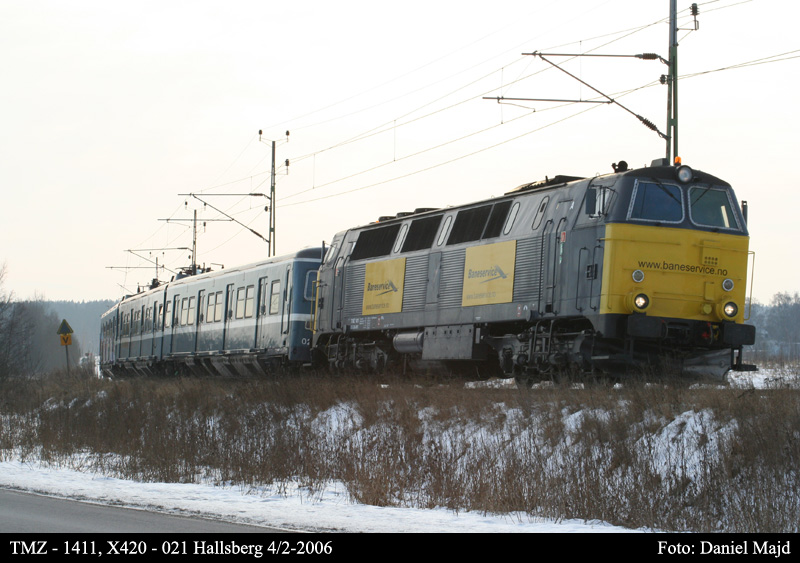
On 4 February 2006, the 021 was transported from Motala to Kristinehamn,
as the last of all X420 EMUs to be scrapped. This time it was the TMZ 1411 (ex.
Danish
State Railways (DSB) Mz 1411) from the Norwegian Baneservice that pulled
the EMU. Even on this occasion, it was the private TOC Tågab that was responsible
for the transport. Photo: © Daniel Majd. On February 7, 2006 the EMU was pulled
the last bit up to Nykroppa scrap yard.
X420 026

On 9 March 2005, the X420 026 calls at Sollentuna, heading a peak
hour train for Tumba. Some numbers lacked at the front of the B-car;
only "26" was left in one of the corners... The EMU was transported
to the Nykroppa scrap yard on 25 November 2005.
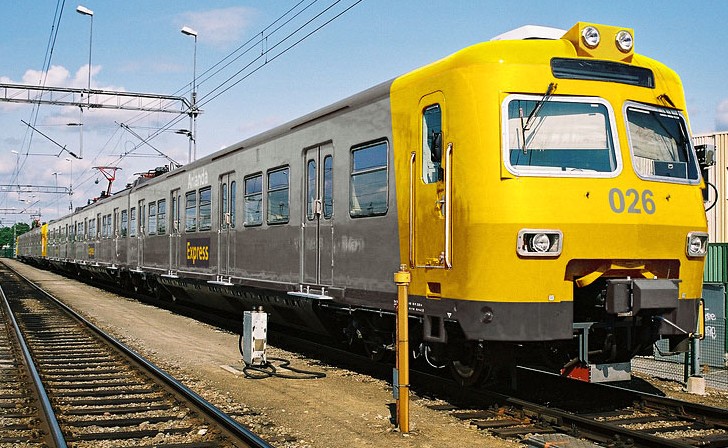
What is this? X420 026 in Arlanda Express-livery! It can't be truth, or? Well, of
course not, but it might have been. In the summer of 2005, DBS was contacted by
a consultancy company, which analysed the supply of traction, which could be
released within short notice. A-Train (the Arlanda Express TOC) needed some
extra capacity, and X420 could have been a possible solution. The advantage
with the train was the floor height, and that it was already permitted to run
in Sweden. The disadvantages, however, were the slower maximum speed (120 km/h,
compared with 200 km/h for the X3
EMUs), the lack of gangway through the train and a quite large administration
for a few train units.
The original picture! I took the photo on 30 May 2003, and Dirk
Mattner, Webmaster for ET
420-Online, did the picture remake.
An X420 line-up with X420 026 in the middle, at the Älvsjö Depot on 4 November 2003.
X420 027
On 6 July 2004, X420 027 heads a Kungsängen to Västerhaninge service,
as it passes by the Old Town (Gamla stan) on the Wasp waist.
On the cold afternoon on 23 December 2003, the X420 027 leaves the
Stockholm Central station on its way to Västerhaninge. One could reckon the 027
A-car on the wrong fitting of the white band to the SL logo…
X420 044
A train for Västerhaninge, headed by X420 044, is ready for departure in
Kungsängen on 1 April 2005.
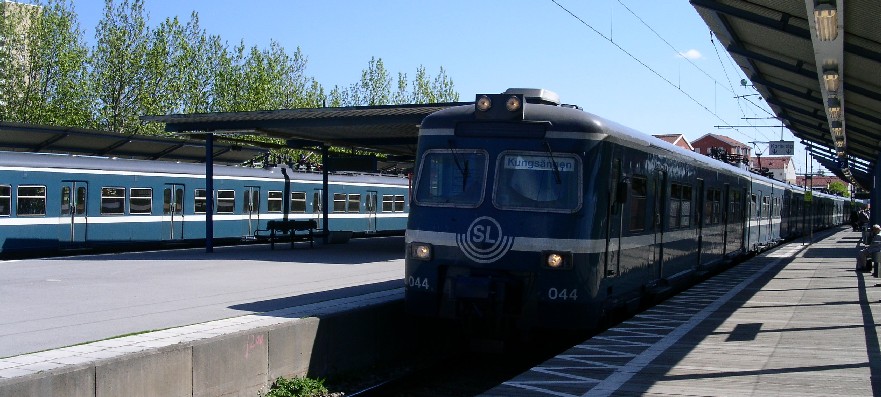
Two ‘German trains’ meets in Jakobsberg on 11 May 2004. The station was
rebuilt at that time; therefore new platforms on the outside were used during
the rebuild time.
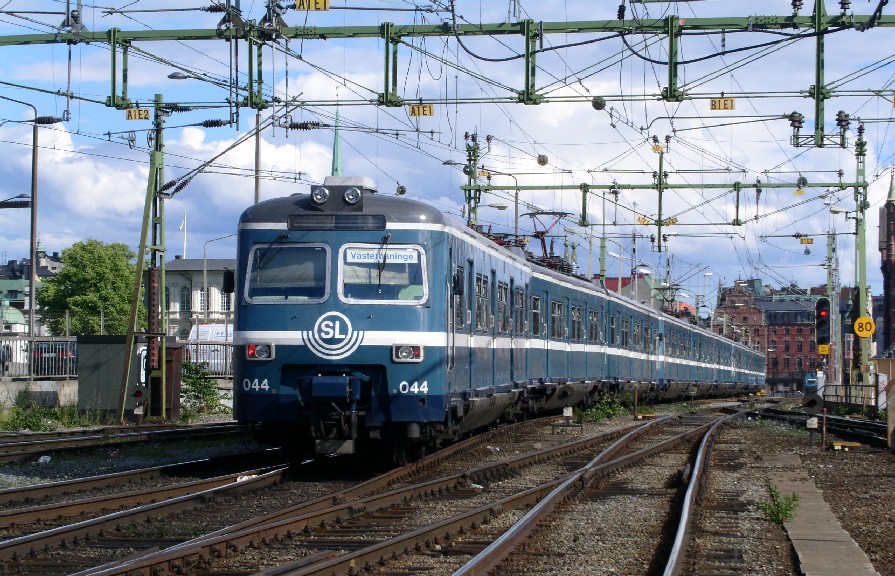
A train to Västerhaninge, tailed by the X420 544, rolls out from the
Stockholm Central station over Tegelbacken onto the South Railway Bridge
(Södra Järnvägsbron), on 7 July 2004,. The line between Stockholm C and
Stockholm S is usually called the Wasp waist, and is one of the most
sensitive parts of the whole rail network in the Lake Mälaren valley. A
disturbance here spreads rapidly through the whole country.
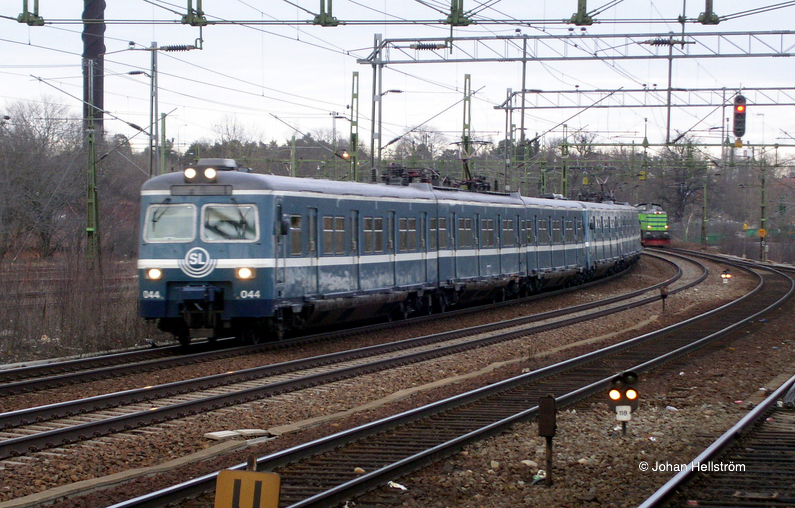
On 29 March 2005, a peak hour train for Tumba, headed by X420 544, was approaching Älvsjö
station. The TGOJ diesel loco T43 228 hides in the background.
Two X420-trains passes at Tumba on 5 October 2005.
The final commercial X420-service took place on December 14, 2005. The
train contained the EMUs X420 044 and 058. Here, the 044 has reached Stockholm
C for the last time. A short, but intensive time for the X420 EMUs X420 in
Stockholm was then finished. The EMU was transferred to the scrap yard on 16
December 2005.
X420 047
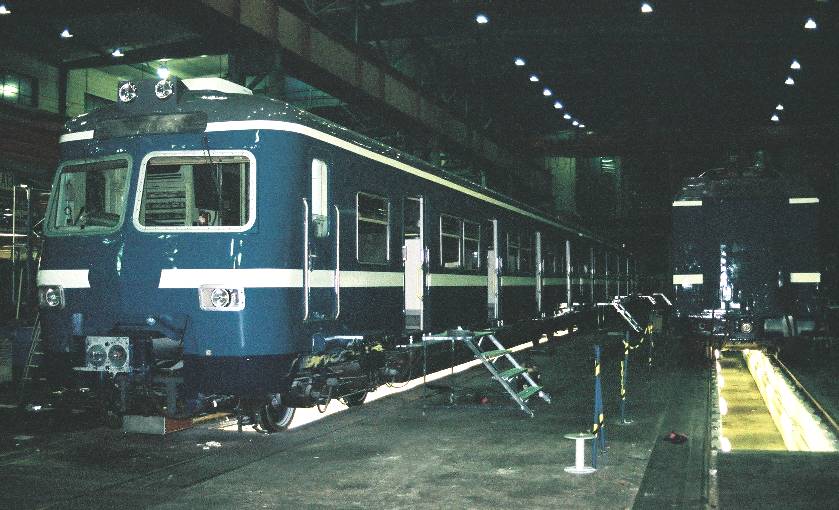
The Motala Works on 4 November 2002. The X420 047 is standing to
the left, and the intermediate car X421 058 in the dark to the right.
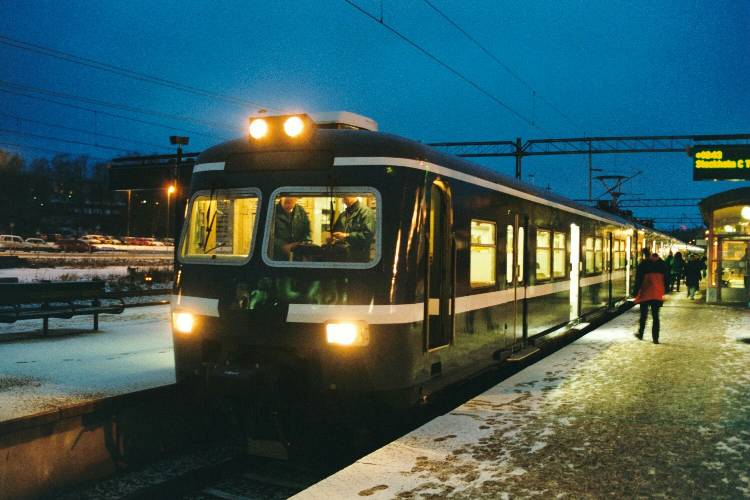
The first commercial X420-service on 20 January 2003! X420 547 is
ready for departure from Upplands Väsby.
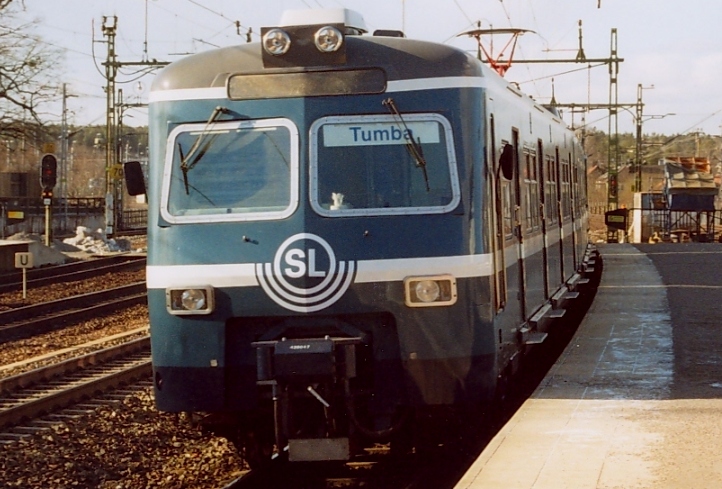
At service! Exactly two months later, on 20 March 2003, the
X420 047 leaves Älvsjö, heading for Tumba. It was still a question of
trial runs, due to that all tasks regarding work environment and train drivers
training weren’t solved at that time. The cover glass to the original destination
sign was coloured by yellow dirt, a typical sign for the unit 047. This unit
was one of the first ones in Sweden, and also one of the first ones being
scrapped.
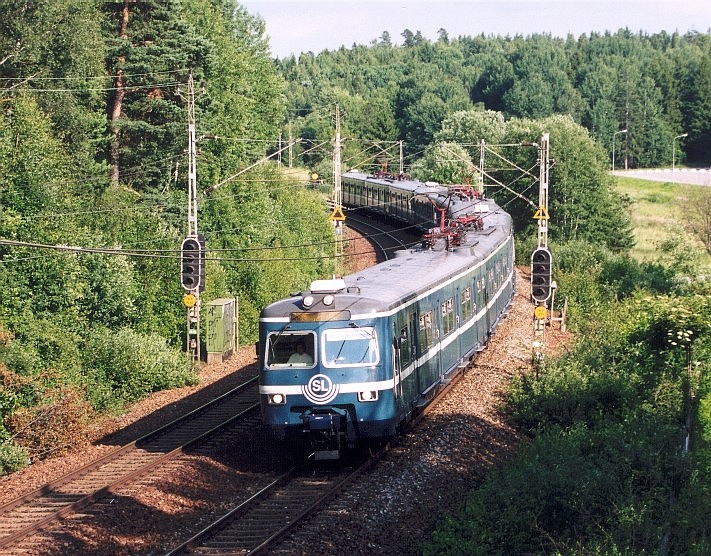
On 8 July 2003, a train bound for Kungsängen, headed by X420 047, has
just passed the entry signal to Jakobsberg.
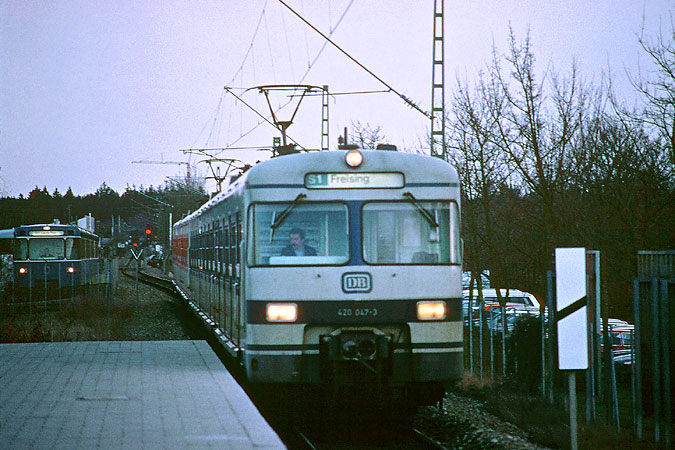
As a comparison, I show you 420 047 some 10.5 years earlier,
entering the Neuperlach Süd station In Munich, in January 1993.
On 22 September 2003, a Västerhaninge to Kungsängen X420 service, tailed by
X420 547, passes Länna, between Haninge centrum (today: Handen) and
Skogås, on the Nynäs branch line.
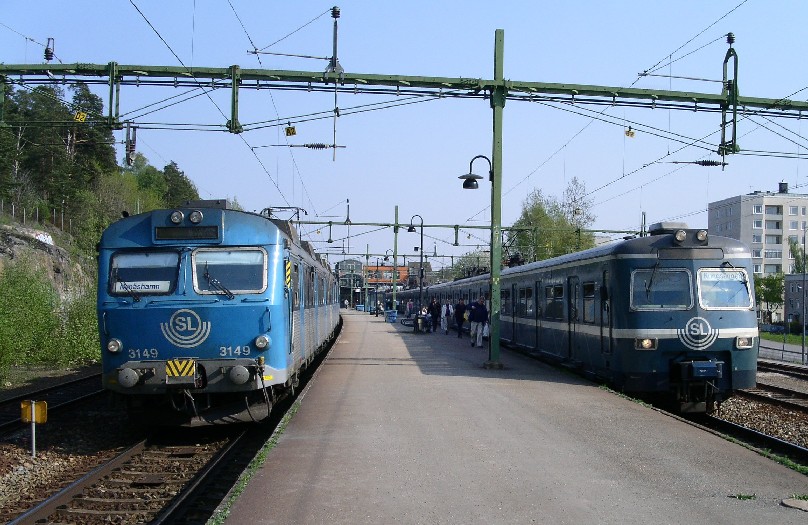
Train meeting in Spånga on 7 May 2004. X10 3149 to the left, and X420 047
to the right.
A peak hour train for Tumba, headed by X420 047, has just left Stockholm C
on 17 August 2004.
X420 047 leaves Sundbyberg, heading for Västerhaninge on the shiny winter day
19 November 2004.
On 27 October 2005, the CargoNet
Di8.705 will within short be coupled to the first X420 train set bound for the
Nykroppa scrap yard. The unit behind the loco is X420 047.
X420 054
X420 every day at Stockholm S on 25 May 2005. The X420 054 has been turned
around again, and runs now with the A-car towards north. The B-car still has
its destination roller band from Munich! One can see the far destination ‘Pasing – Zug halt nicht überall’ (Pasing
– Train does not call on every station).
DESTINATION NYKROPPA SCRAP YARD.
The absolute
final X420 train, containing the units 054 + 058 + 044, bound for the
scrap yard in Nykroppa in western Sweden, calls shortly at Södertälje
syd on 16 December 2005.
The Nykroppa scrap yard is reached. Photo: © Niklas Biedermann. You will
find more pictures in Niklas Biedermann's X420-gallery.
X420 058
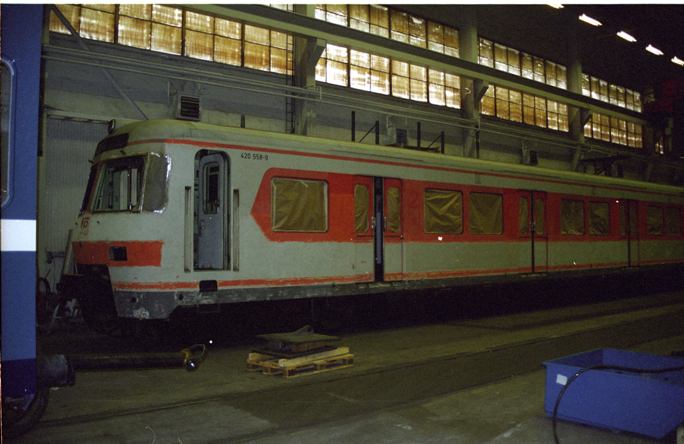
On 25 October 2002, the B-car X420 558 is waiting for being repainted in
the Motala Works. The
420 058 was one of the first units in Munich, that was repainted in the
official S-Bahn orange/light grey colour scheme in the 1980s.
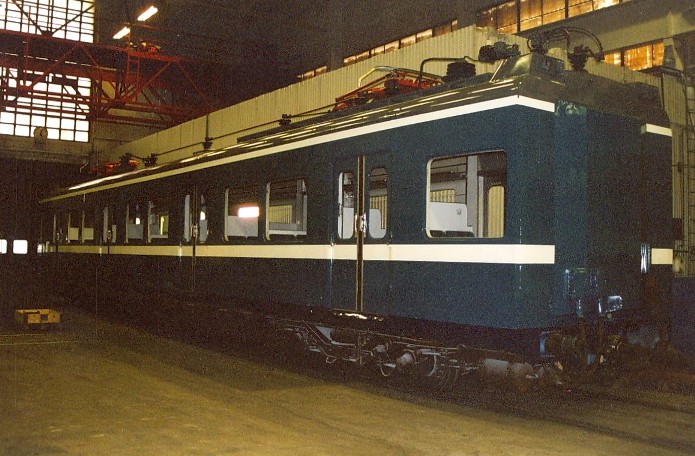
The newly repainted intermediate M-car X421 058 in the Motala Works, on 25 October 2002.
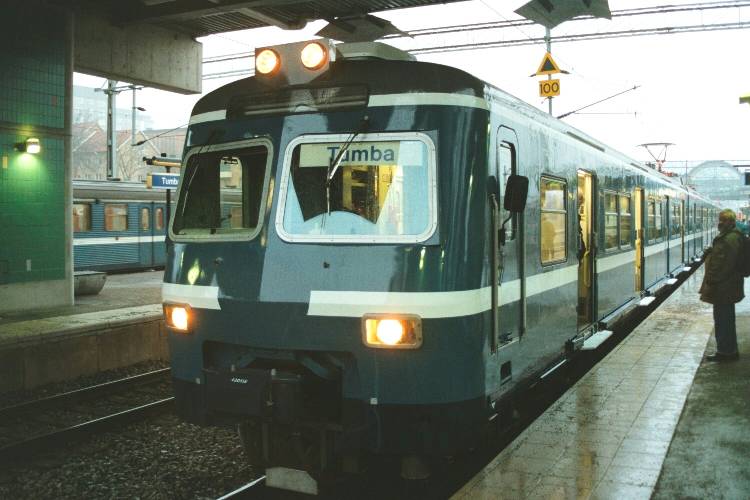
Another picture from the first commercial X420 service, on 20 January 2003.
X420 558 is about to leave Tumba as an empty run for Älvsjö.
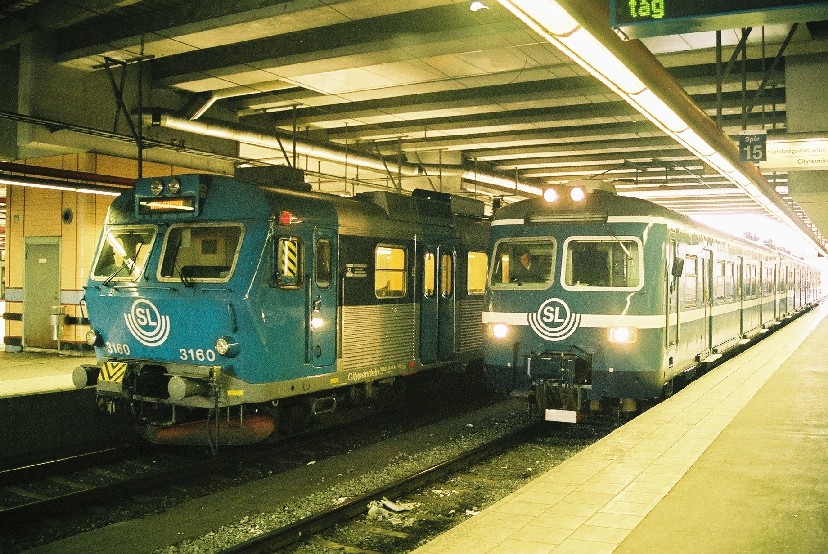
Ten days later, on 30 January 2003, the X10 3160 and X420 058 meets in
Stockholm's central station.
On the last commercial service on 14 December 2005, X420 058 calls at Karlberg en route to Tumba.
X420 058 was the third X420 EMU
that was delivered to Stockholm, and was also part of the first commercial
service on the 20 January 2003. The unit’s A-car was easy to recognise through
the up-side-down fitting of the white band to the SL-logo!
X420 060

The first and the last! X420 060 was the first unit, that reached
Sweden. It arrived in October 2001 and was rebuilt and tested as a prototype
(also called’ the Forerunner’). The unit arrived in Älvsjö on 13 December 2001
and is seen here the same day on track 9 in the depot.
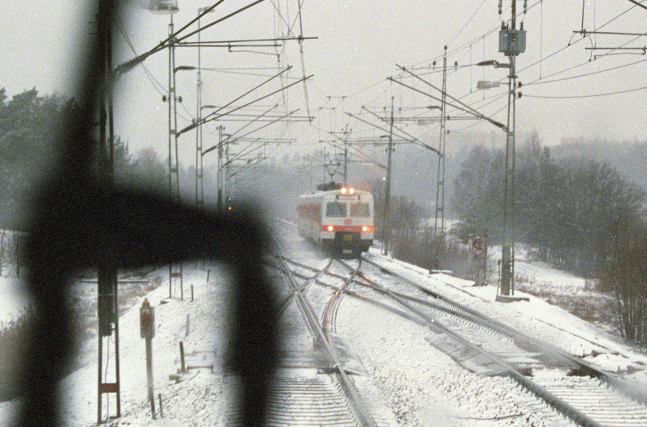
A trial working with X420 060, passes Barkarby on 24 January 2002.
Unfortunately, the wind screen wiper disturbes the picture a bit, but it's the only picture I've got from the trial workings with this unit.
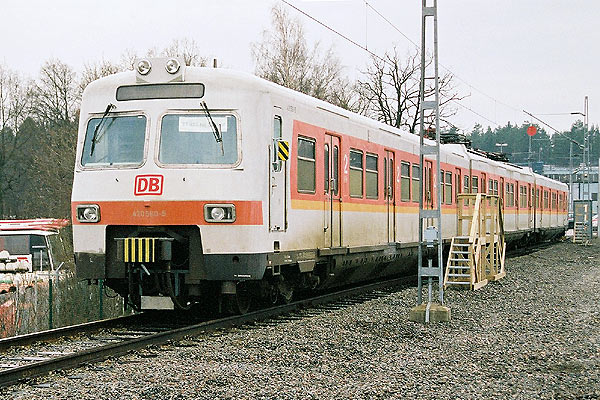
On 4 Februay 2002, the unit X420 060 is seen standing on a siding
in the Älvsjö depot area. It took still almost a half year, before the
contracts between SL, DBS and Citypendeln were signed.
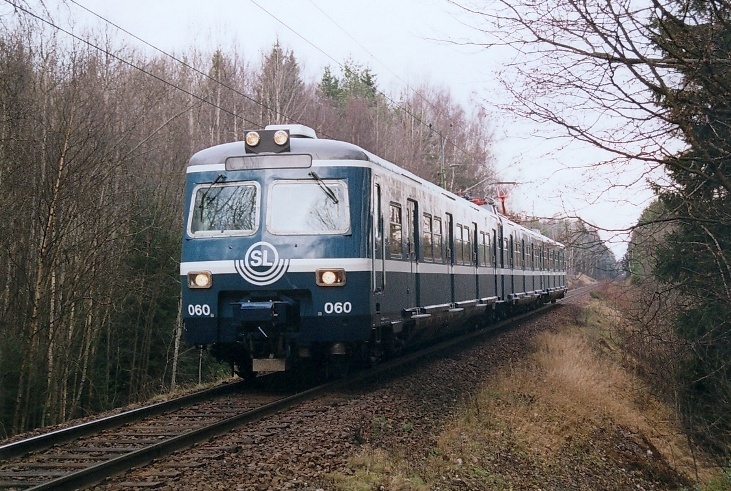
X420 060 outside Mariedamm, between Hallsberg and Motala, on 10 December 2003.
On board the special were representatives from DBS, DB Regio AG, SL
and Citypendeln. We were on our way to Motala, where we met people from
Bombardier and the Motala Works. The task was to close the project.
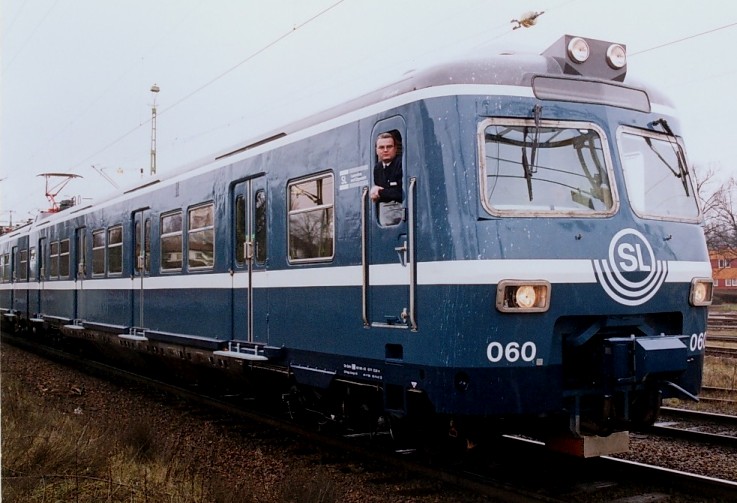
Me posing in the driver’s cab on X420 060 in Hallsberg on 11 December 2003, on our way back from Motala.
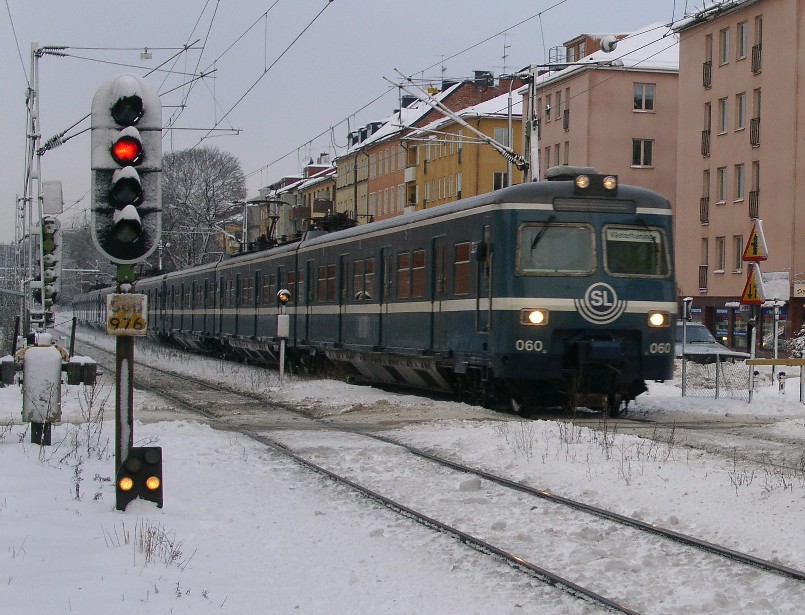
Another picture, taken on 24 November 2004, where the X420 060
passes the level crossing Esplanaden in Sundbyberg. Almost a year later,
this unit went on the trip “to the last point”…
X420 062
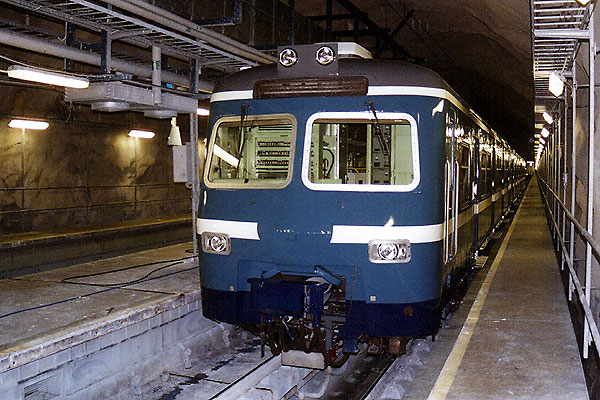
The first X420 EMU in SL-blue livery was the 062. On 9 October 2002
(one day after its arrival), it stands in the de-icing tunnel in the Älvsjö
depot.
X420 062 waiting i a siding in Alvesta en route to Trelleborg on 6 November 2002.
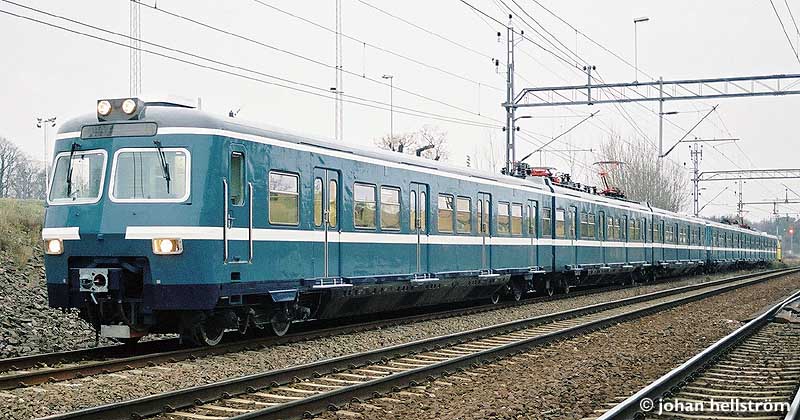
In the afternoon on 7 November 2002, the first Vollzug in
SL-blue livery is ready to depart from Motala. The train contained the units
X420 062 + 047. Behind the train hides the small loco ‘Gulingen’ (‘The
Yellow’), which belonged to the Motala Works. I had the honour to drive the
train ‘home’ to Älvsjö, and was the first train driver at Citypendeln, that
drove an X420 train set containing two SL-blue units.
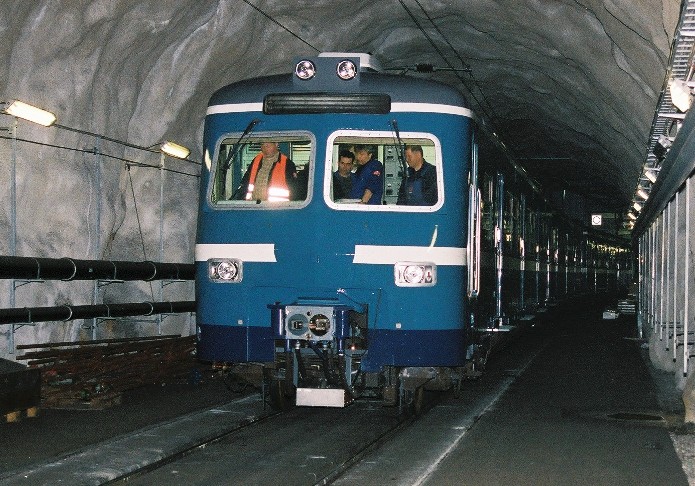
On 29 November 2002, technicians from DB in Germany are
working on the unit X420 062 in the ‘washing tunnel’ at the Älvsjö depot.
One speciality with the 062 was that the tail signal holder wasn’t removed on
this unit, apart from the other 14, where it was stated that the holder stood
in the way for the SL logo.
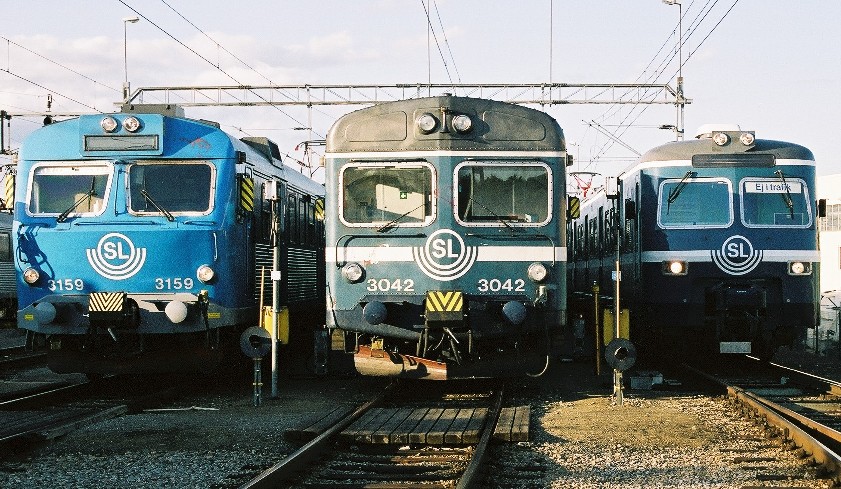
Three times X! The SL Pendeltåg fleet 2002-2005. From the left to the
right: X10 3159, X1 3042 and X420 062 in the Depot yard at Älvsjö, on 10 May
2003.
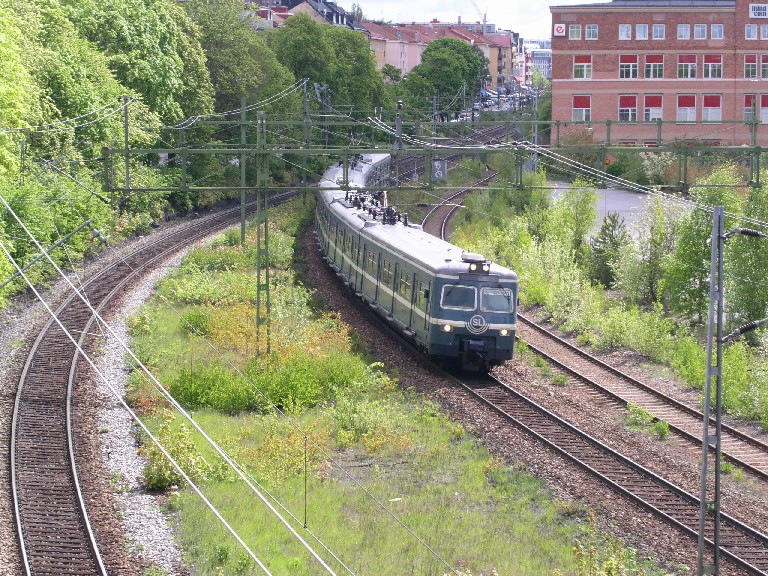
A Västerhaninge to Kungsängen service, containing X420 062 + 117, passes
on 15 May 2004 the former halt Sundbybergs Norra (north). One can clearly see
where the platform once was.
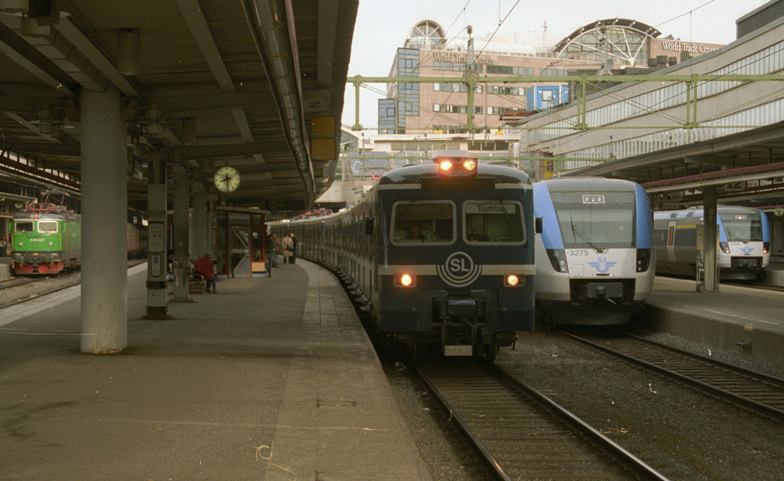
X420 562 at Stockholm C on 18 March 2003.
To the left one can see a so called Danish Train and to the right stands a couple of SJ's Regina-EMUs.
The picture is historic; none of these trains are now in service in the Stockholm area.
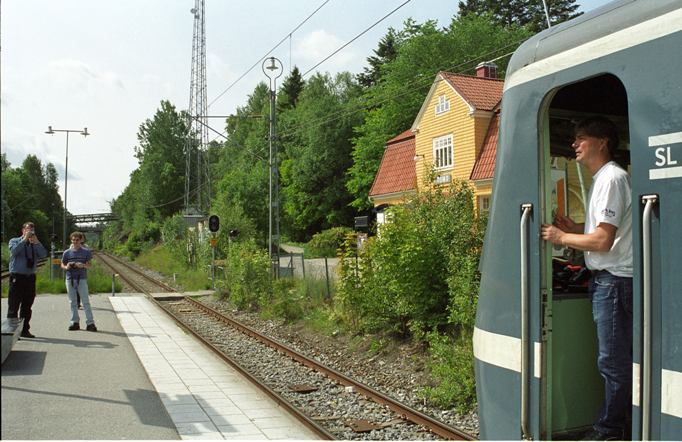
Ösmo station on the Nynäs branch line. On 21 June 2004, the X420 062 was
used for GSM-R test runs through the Pendeltåg
network. Onboard were staff from Citypendeln and DBS as well as some rail
enthusiasts from Germany…
X420 562 calls at Tullinge halt in the morning on 4 November 2005,
the last day in service. After arriving at Stockholm C, the train set was taken
out of service, turned around immediately and went direct to Kristinehamn and
the Nykroppa scrap yard.
X420 065
X420 565 bound for Västerhaninge arrives at Sundbyberg on 17 October 2003.

X420 065 is being shunted at the Hagalund depot, on 24 February 2005.
To the right in the background a pair of SJ’s new double-decker EMUs X40.
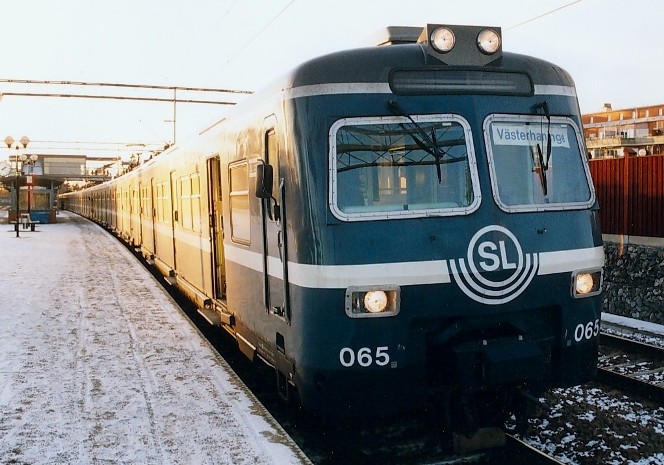
X420 565, heading the Kungsängen to Västerhaninge train 2539, is
ready for departure from Kungsängen on 8 December 2003. A week earlier, I
started working at DBS, and this was on of my first roster after the X420
training.
X420 067
On 13 October 2004, the X420 067 is heading south on the so
called Wasp waist. This unit was used
at the inauguration trip on the new line to Frankfurt (Main) Airport in 1972. At
that time, Frankfurt/M had no own ET 420 EMUs, so they borrowed a light
grey/blue-livered unit from Munich in stead!
X420 067 calls at Sundbyberg in the evening, on 26 April 2005.
The unit 420 567 had about one month left in service, as it heads
the Tumba to Stockholm C peak hour service, calling at Huddinge on November 16,
2005. On 12 December 2005, it was driven to Kristinehamn by me, and directly afterward
transported to the Nykroppa scrap yard.
X420 110
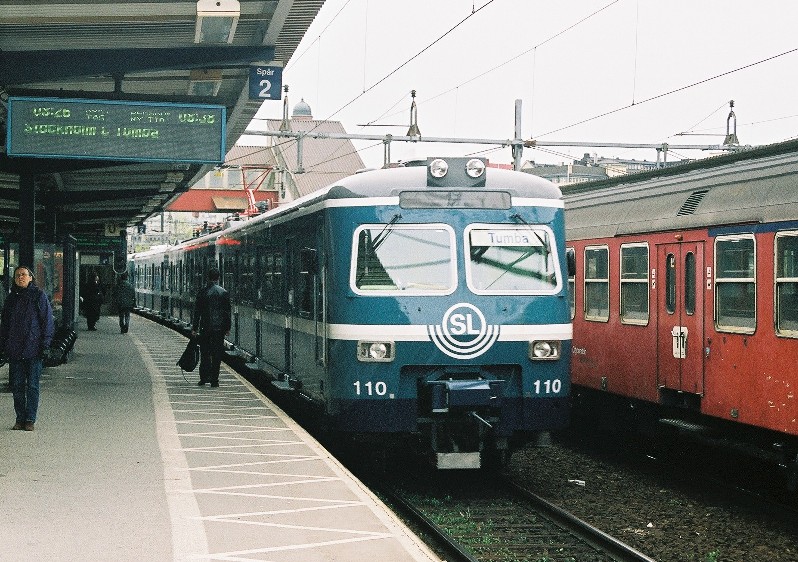
German and Danish in Karlberg on 14 May 2003.
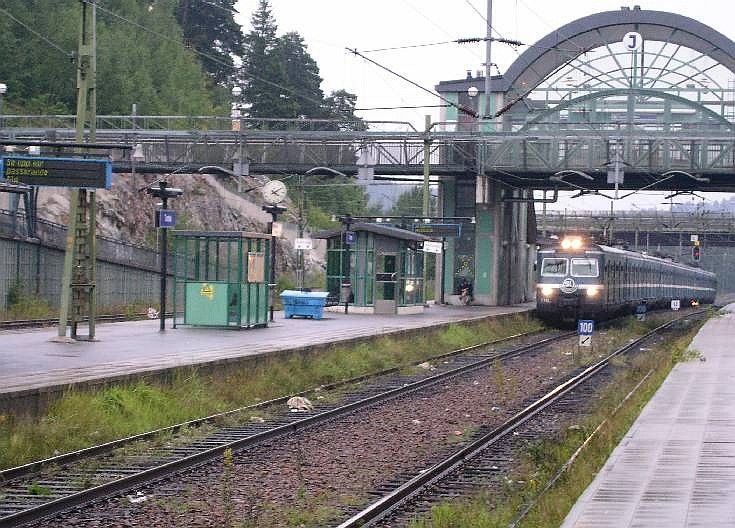
Tumba on 19 August 2004. X420 110 is heading an Älvsjö to Tumba empty working.
Stockholm C on 4 November 2005. To the left, the X420 110 heads a ‘scrap
yard working’ for Nykroppa, waiting for departure. The train set arrived less
than half an hour before as the Tumba to Stockholm C peak hour service 2920. To
the right, the following Tumba to Stockholm C peak hour service 2922 has just
arrived, tailed by the X420 044. A few minutes later, the ‘scrap yard
working’ left for Kristinehamn, where it immediately was coupled to a diesel
loco and transported on the Inland line to the Nykroppa scrap yard. This was
(and still is) probably unique in Swedish rail history; that a train
immediately after being taken out of service was driven to the scrap yard,
fully operational…
The former halt Sundbyberg Norra (north) was situated just a bit further
west out of Sundbyberg station. It was closed already in the mid 1960s. Still,
one can clearly see where the platform once was. On 28 September 2004, the
X420 110 passes by ‘in the green’. The front number marking on the A- and
B-cars were different…
X420 117
X420 117 at Bålsta station on 31 July 2004, pictured on the same day
as the unit 021 above. This unit was originally thought to be the Munich museum
EMU. Instead, the 420 001
now belongs to the DB Museum
operational rolling stock.
A train bound for Kungsängen with X420 117 at the end, crosses the new
Årsta bridge on 1 September 2005. The 117 belonged to the three first units,
which were scrapped.
The four kinds of commuter trains together at the Älvsjö depot, on the
24 October 2005; X60, X420, X1 and X10.
X420 119
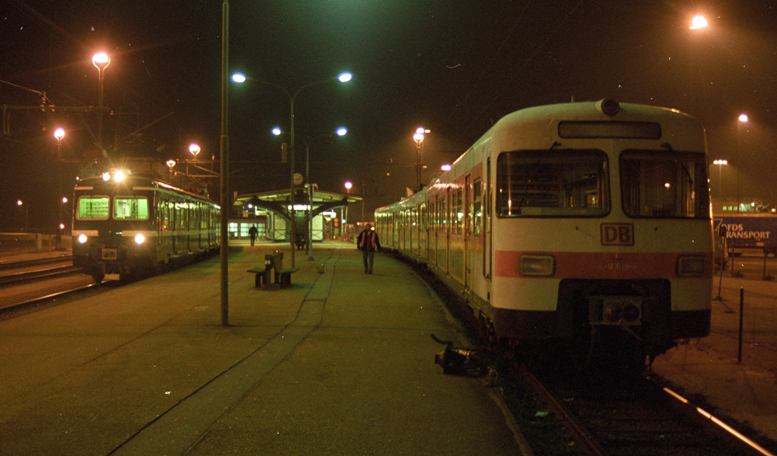
Early morning pick-up at the Trelleborg ferry terminal, on 7 November 2002.
To the left the X420 062 and to the right 420 119. The latter had
just before been pulled of the train ferry from Germany. Both EMUs were coupled
together and driven up to Motala in multiple mode. Almost three years later, on
November 25, 2005, the 119, together with 026 and 065 were driven to the scrap
yard.
Later in the same morning, 420 619 and X420 062 stands side by side in
Motala.
On 22 September 2003, a Västerhaninge to Kungsängen service, headed
by X420 119, passes the former station Drevviken between Haninge centrum
(today: Handen) and Skogås. The train driver greeted me with the whistle and a
blink with the tail lamps!
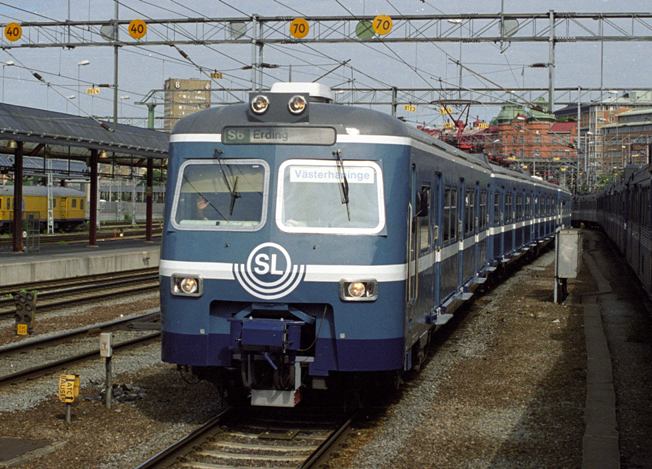
X420 619 (with two destinations S6 - Erding as well as Västerhaninge),
heading a Kungsängen to Västerhaninge service on 16 June 2003, passes the
“X1 reserve train” on the Norra Bantorget platform site, entering the Stockholm
C main station. The original Munich destination roll bands were never removed
from the B-cars 619 and 554. Therefore, one sometimes could see some
interesting destinations outside Sweden, so to say…
Miscellaneous
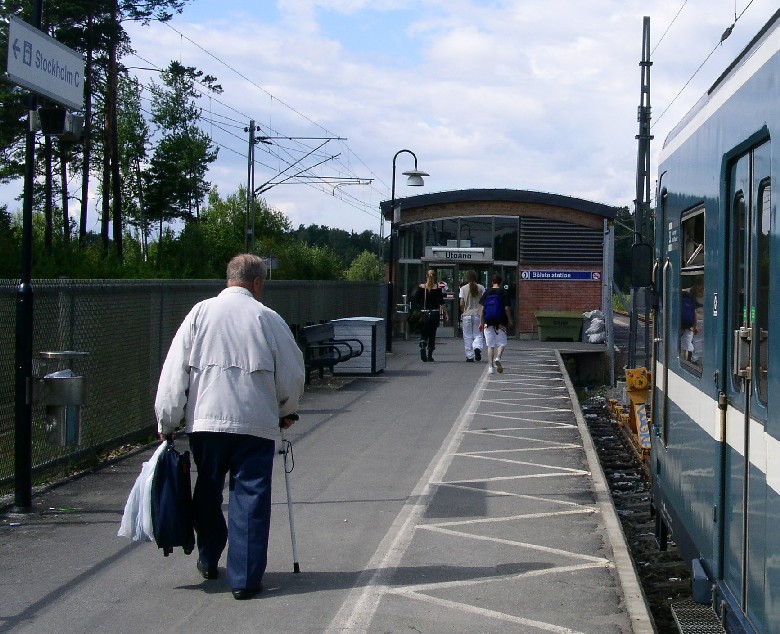
"Bålsta – Terminus". This is the end of the line fort he Stockholm
commuter trains, actually outside the Stockholm County (län). An X420-train has
reached Bålsta on 31 July 2004, and the passengers leave the station.

Two X420 trains passes at Spånga station on 4 January 2005.
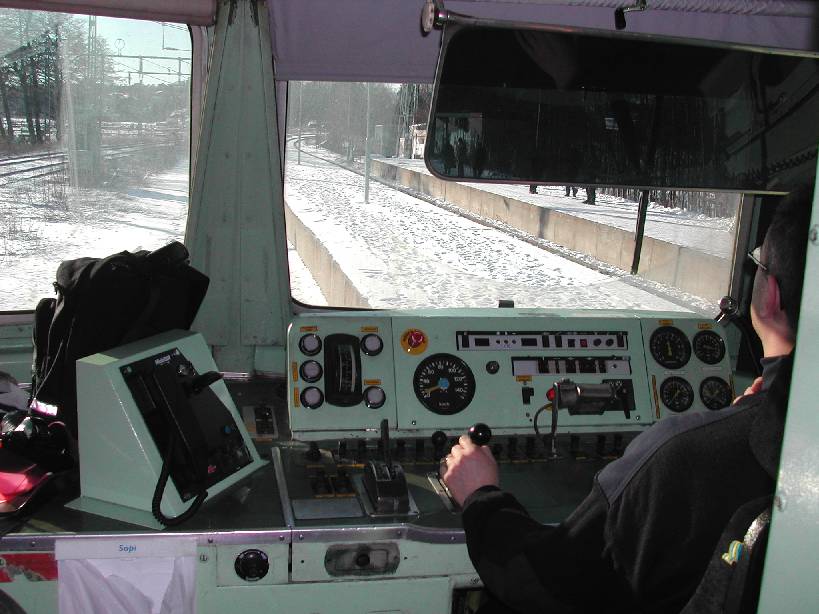
The driver’s cab in the X420 020. I’m about to call at an odd station
for an X420; Nynäshamn, coming from Nynäshamns färjeterminal (ferry terminal)!
This was never ordinary ‘X420-country’, but the picture was taken during a test
run on 11 February 2004. Today, this picture is historical in many ways; the
line to the ferry terminal is closed, the Nynäshamn station has been rebuilt
and the X420 EMUs are scrapped. Photo: © Jonn Persson.
I drove the first train for the Nykroppa scrap yard, the first part to
Flemingsberg. Due to different reasons, I couldn’t join the train all the way
to Nykroppa. The circle was in a way closed – I also drove the new delivered
047 from the Motala Works in November 2002…Photo: © Jonn Persson.
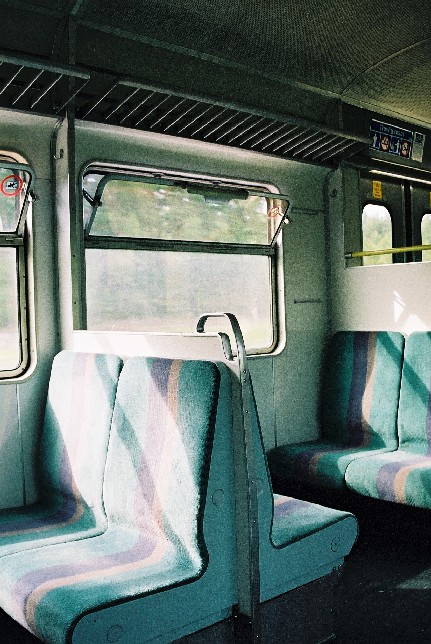
Inside an X420.
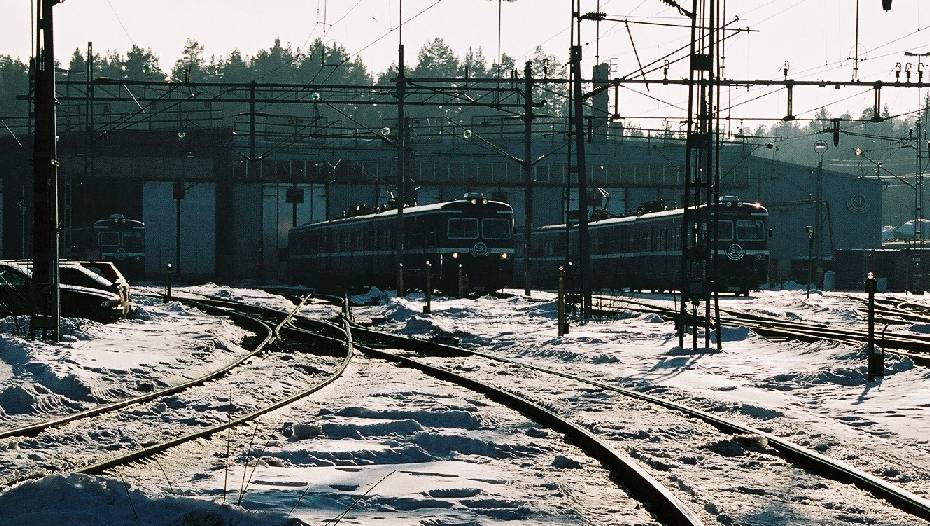
Three X420 outside the Älvsjö depot on 19 February 2003.
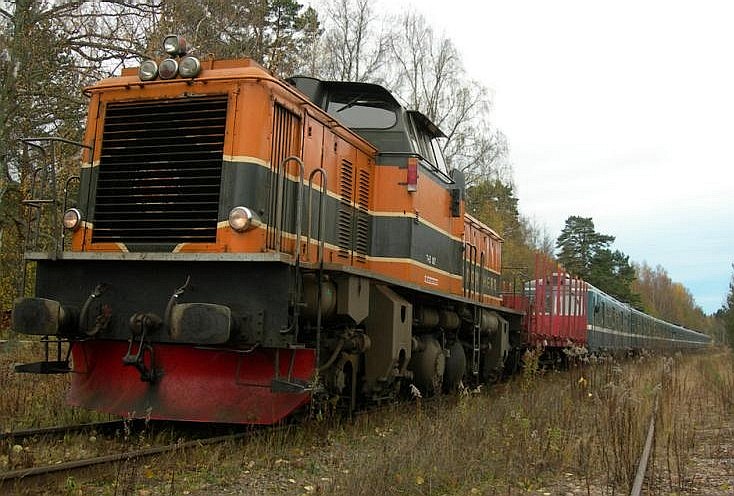
The first two trains for the Nykroppa scrap yard were pulled from
Kristinehamn by the T43 107 in Great Northern-livery, belonging to the private
TOC Tågåkeriet i Bergslagen AB (Tågab). On this picture, taken on 27 October 2005, the
train has just reached Nykroppa. Photo: © Jonn Persson. You’ll find more
pictures in Jonn Persson's
picture gallery.
The third X420-scrap train was pulled from Kristinehamn by the Nohab
diesel loco TMX 104, belonging to Tågab. The loco became its special livery
during the ATC test runs in Denmark. Photo: © Niklas Biedermann.
On 12 December 2005, the forth train set (X420 027 + 067) was driven
to the scrap yard. The train, with the two Tågab Z65 diesel shunters 203 + 208
in multiple mode, is about to leave Kristinehamn for Nykroppa.
The fifth and last transport to Nykroppa took place, as already
mentioned, on the 16 December 2005. The train has made a photo halt at the Nässundet
Bridge on the Inland Railway. The Tågab T43 107 pulled the train this time
as well. Photo: © Niklas Biedermann.
Not a beautiful sight… The last point has been passed… Photo: © Niklas
Biedermann. In the Jacob
Ehrensvärd picture gallery you can find more sad pictures from
Nykroppa, as well as in Niklas Biedermann’s X420 gallery.
As all the train sets now are scrapped, only memories, pictures, films
and models remains. Here you can see some items in my 420 model collection.
Left, an X420 wooden train (!), X420 067 in final livery and X420 060
as the ‘Forerunner’ (handmade N-models by Jörgen Edgar)
as well as the ET 420 044 in original livery from Roco.
This is a model of an ET 420 with the Stockholm look, on a model railway
exhibition on the Swedish National Railway Museum in Ängelholm in connection
with the 150 years jubilee of the Swedish railways in 2006. This is an Arnold
N-model, without any rebuilding. Though is it a good example of how the X420
would have looked like, if the real rebuilding weren’t done.
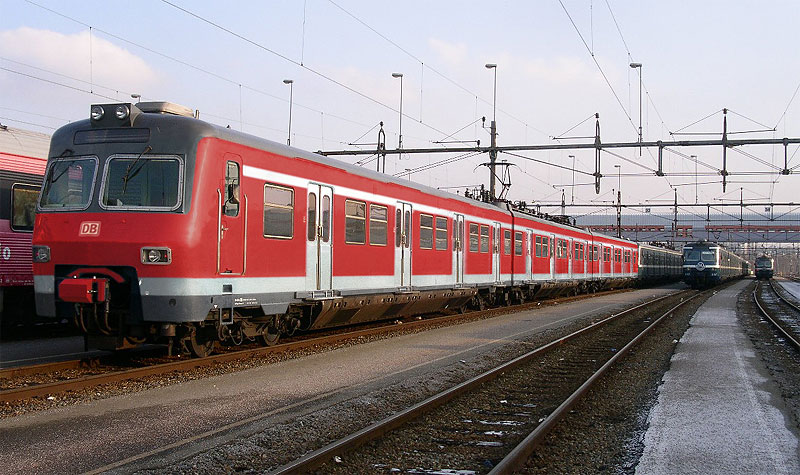
The X420 020 (still without the number fitted) stand newly repainted in the
Hagalund depot on 1 April 2005…
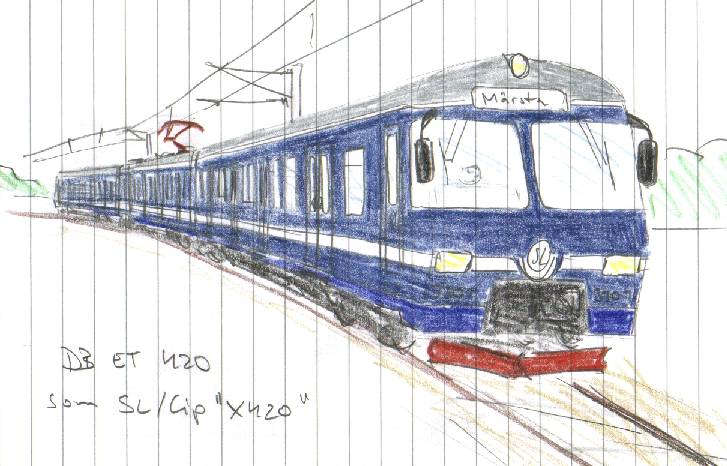
Last a drawing I made, when I first heard about the 420-plans in 2001. I
must say, that I wasn’t that far from the reality!
SL Pendeltåg (in Swedish) Home På svenska Auf Deutsch
Last update: 28.09.2015
Webmaster Johan Hellström
© Johan Hellström 2004-2015